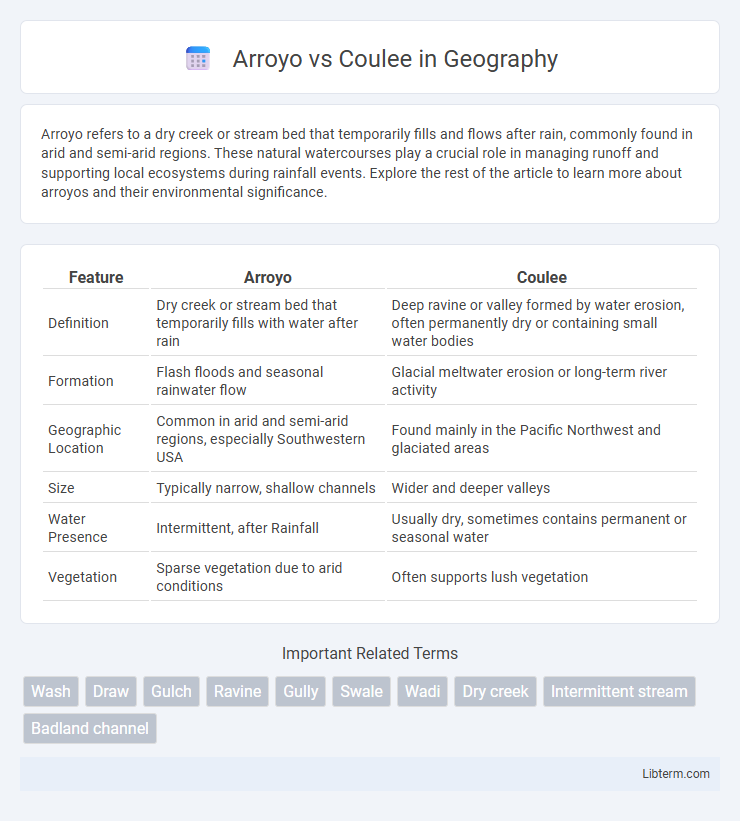Arroyo refers to a dry creek or stream bed that temporarily fills and flows after rain, commonly found in arid and semi-arid regions. These natural watercourses play a crucial role in managing runoff and supporting local ecosystems during rainfall events. Explore the rest of the article to learn more about arroyos and their environmental significance.
Table of Comparison
| Feature | Arroyo | Coulee |
|---|---|---|
| Definition | Dry creek or stream bed that temporarily fills with water after rain | Deep ravine or valley formed by water erosion, often permanently dry or containing small water bodies |
| Formation | Flash floods and seasonal rainwater flow | Glacial meltwater erosion or long-term river activity |
| Geographic Location | Common in arid and semi-arid regions, especially Southwestern USA | Found mainly in the Pacific Northwest and glaciated areas |
| Size | Typically narrow, shallow channels | Wider and deeper valleys |
| Water Presence | Intermittent, after Rainfall | Usually dry, sometimes contains permanent or seasonal water |
| Vegetation | Sparse vegetation due to arid conditions | Often supports lush vegetation |
Definition and Overview of Arroyo and Coulee
An arroyo is a dry creek or stream bed that temporarily fills with water after heavy rains, commonly found in arid and semi-arid regions. A coulee refers to a deep ravine or valley formed by glacial erosion or volcanic activity, often containing a seasonal or permanent watercourse. Both arroyos and coulees are important geological features representing distinct landform processes and hydrological behaviors.
Etymology: Origins of the Terms Arroyo and Coulee
The term "arroyo" originates from Spanish, meaning a dry creek or streambed that temporarily fills with water after rain, reflecting its frequent use in the southwestern United States. "Coulee" derives from the French word "couler," meaning "to flow," and describes deep ravines or valleys formed by water erosion, commonly found in the Pacific Northwest and northern plains of the U.S. Both terms highlight regional linguistic influences and geological characteristics tied to intermittent water flow and landforms shaped by erosion.
Geographic Distribution: Where Are Arroyos and Coulees Found?
Arroyos are primarily found in the southwestern United States, especially in arid and semi-arid regions such as Arizona, New Mexico, and Texas, where intermittent water flow shapes these dry creek beds. Coulees are more common in the Pacific Northwest and northern Great Plains, including states like Washington, Idaho, and Montana, often formed by glacial and volcanic activity that created deep valleys or ravines. These distinct geographic distributions influence the environmental conditions and ecosystems surrounding arroyos and coulees.
Formation Processes of Arroyos vs Coulees
Arroyos form primarily through rapid erosion caused by intense, short-duration flash floods that carve narrow, steep-sided channels in arid or semi-arid regions. Coulees develop from slower, more prolonged erosional processes, often linked to glacial meltwater or extensive surface runoff that creates broader, deeper valleys with gentler slopes. Both landforms result from water erosion but differ significantly in hydrological intensity and geologic context driving their formation.
Physical Characteristics: Comparing Shape, Size, and Features
Arroyos are typically narrow, steep-sided channels formed by intermittent water flow in arid regions, often exhibiting sharp, V-shaped cross-sections and depths reaching several meters. Coulees are broader, wider valleys or basins with gentler slopes, commonly spanning several kilometers in width and characterized by their flat bottoms and extensive terraces. The key physical difference lies in their scale and morphology: arroyos are smaller, incised channels with active erosion, while coulees represent larger, ancient landforms shaped by past glacial or volcanic activity.
Hydrology: Water Flow Patterns in Arroyos and Coulees
Arroyos exhibit ephemeral water flow, primarily channeling sudden storm runoff through steep-sided, narrow valleys in arid and semi-arid regions, leading to rapid but short-lived hydrological events. In contrast, coulees often serve as ancient or current drainage pathways with broader, less steep channels that can sustain more prolonged surface or subsurface flow, sometimes supporting wetlands or groundwater recharge zones. The geomorphology and sediment composition of arroyos promotes flash flooding and erosion, whereas coulees tend to facilitate more stable or seasonal water flow patterns influencing regional hydrology and ecology.
Ecological Importance of Arroyos and Coulees
Arroyos and coulees serve critical ecological roles by providing unique habitats that support diverse plant and animal species adapted to intermittent water flow conditions. These landforms contribute to groundwater recharge and soil moisture retention, enhancing local biodiversity and ecosystem resilience in arid and semi-arid environments. Their natural water conveyance functions help mitigate erosion and sustain riparian vegetation crucial for stabilizing stream banks and maintaining wildlife corridors.
Human Interaction and Land Use
Arroyos, typically narrow and steep-sided channels, influence human land use by directing urban development away from flood-prone areas, while promoting agriculture and infrastructure placement in more stable zones. Coulees, broader and often formed by glacial or volcanic activity, serve as natural corridors for transportation routes and recreational use, impacting settlement patterns through their accessibility and fertile surroundings. Both landforms require careful management to mitigate erosion and flooding risks vital for sustainable human interaction and land utilization.
Notable Examples Around the World
Arroyos, such as the Arroyo Seco in California, are prominent dry creek beds that rapidly channel water during heavy rains. Coulees, like the Grand Coulee in Washington State, are deep, steep-sided valleys formed by ancient glacial floods and are often utilized for hydroelectric power generation. Both features exemplify dramatic water-carved landscapes found in arid and glaciated regions worldwide, highlighting diverse geological processes.
Arroyo vs Coulee: Key Differences and Summary
Arroyos are steep-sided, narrow channels typically found in arid regions formed by rapid water erosion during heavy rainfalls, while coulees are broader, deeper valleys often created by glacial or volcanic activity. Arroyos usually have dry streambeds that flow intermittently, contrasting with coulees which may hold lakes or permanent streams. The primary differences lie in their formation processes, size, and water retention characteristics, with arroyos reflecting flash flood dynamics and coulees representing larger-scale geologic events.
Arroyo Infographic

 libterm.com
libterm.com